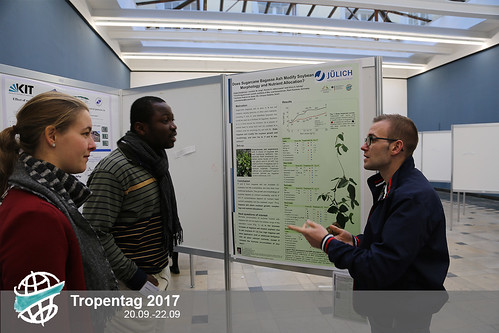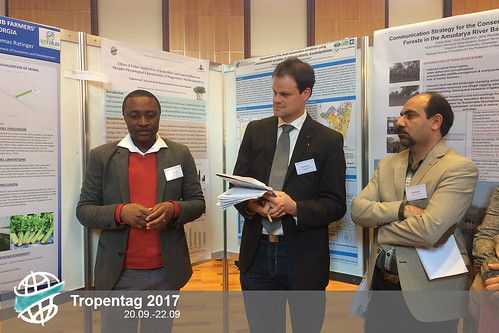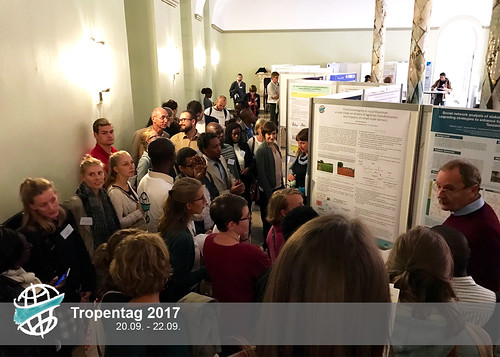Poster Sessions 2017
Tubers that don't want to grow up!
Thu, 09/21/2017 - 09:55 — giulia.rotanodari Stacy Hammond from the Czech University of Life Sciences conducted a brilliant investigation on how to effectively slow down the growth rate of Ulluco (Ullucus tuberculosus)(Loz.) of the Basellaceae family, an important Andean staple crop, so it can be efficiently conserved for farmers and for future generations. I certainly hope that these findings will serve as a basis for future studies in genetic resources and conservation.
Stacy Hammond from the Czech University of Life Sciences conducted a brilliant investigation on how to effectively slow down the growth rate of Ulluco (Ullucus tuberculosus)(Loz.) of the Basellaceae family, an important Andean staple crop, so it can be efficiently conserved for farmers and for future generations. I certainly hope that these findings will serve as a basis for future studies in genetic resources and conservation.
Model Fashions
Thu, 09/21/2017 - 01:14 — kristianj71I reluctantly made my way to the modelling poster presentations. There’s a grimy romanticism to agriculture in the tropics and subtropics, it’s hot, sweaty and dirty. Even measuring the leaf area index with a Plant Canopy Analyzer requires patience in sweltering heat. Modeling conjures a different image, endless hours staring at a screen tinkering with a tangled web of components.
This is only half the story, it also requires intensive field work too. Models can only be created and calibrated based on real data. Above all, modeling is part of the future of agriculture. Without it, it’s nearly impossible to show the advantages of intercropped systems, or the diffuse impacts of global warming.
Unfortunately, the poster session just made a complicated subject more obscure. The noise drowned out most of the presenters along with the questions. Regardless, I got enough of an impression to make a list of my favorites. I made sure my choices made sense by pulling aside a modeler from the audience.
Best Poster
Thanh Thi Nguyen: Assessing Impacts of Long-Term Maize-Cultivation Using the ‘Dynamic of Total Carbon and Nitrogen Distribution’ Model

New strategies and models in Central Asia
Wed, 09/20/2017 - 19:47 — Hana KhanhEven though the first poster session of Tropentag 2017 began late in the afternoon in the AULA, the audience was still excited and enthusiastic for the 11 presentations on Central Asia. Honestly, one hour and a half is not enough time for all the researchers to present their work in the depth their passion showed they deserved.
And that was exactly the case for Welcome Zimuto from the Czech university of Life Sciences. He brought to the session a poster describing his work on modeling alternative profit maximisation and crop-land allocation strategies for two cooperative herb farms in Georgia. Although the limitation of the model he used was when the price of inputs fluctuates, his results are applicable and should interest further development.
Meanwhile, Elena Kan presented her research on communication strategies for preservation of the flood-plain forest in the Amudarya River Basin in Uzberkistan. Her efforts to work with a variety of different stake holders for her research was both interesting and valuable.
Late start. Inaudible. THE NEW DIRECTION OF AG!
Wed, 09/20/2017 - 19:42 — megreslerOne audible theme carried across the session: a need for distinctly long-term thinking when seeking solutions for food system transformation. Despite the challenging circumstances, the fourteen presenters of Poster Session 1 "Institutions and Livelihoods" on Wednesday afternoon brought innovative research into discussions of gender and rural sociology.
From whether childhood experiences influenced the decision to migrate or not from rural areas in Ethiopia, to considerations of gender and social hierarchy in forward-looking decisions within Tanzanian vegetable production, these posters were representative of the direction future agricultural research is moving in.
While not complaining about the additional 60 seconds added to her presentation time due to the late-start and missing presenters, Mst. Tania Parvin from the University of Hohenheim explained, "I think next time we should start on time... the last person might be presenting in front of no audience."Speaking from an air of frustration with the volume of the presentations Parvin's colleague Mary added the suggestion, "Maybe next time they should provide a mic?"
Soil Matter(s) - More Attention Please!
Wed, 09/20/2017 - 19:42 — schumacherlydiaIn the AULA, the poster session started with only a handful of patient Tropentag participants as the plenary session dragged on without end. After a few posters were presented, it got more and more crowded, to the point that standing two meters away from the speaker made it impossible to hear, much less understand. Conversations among the gaggle watching made it even harder. Camera and t-shirt made it clear I was there on business, and people made way so I could capture the the main content.

Based on the presented posters during the first session, soil and its components (it's a 4-dimensional object!) play a vital role in sustainable food production and therefore our future. The young researchers tried to find ways to use the many qualities of soil. Vitalij from the Juelich Institute had researched the effects of recycling sugarcane bagasse, a byproduct of industrial processing, when applied in soybean cultivation to increase nutrient availability and uptake.







